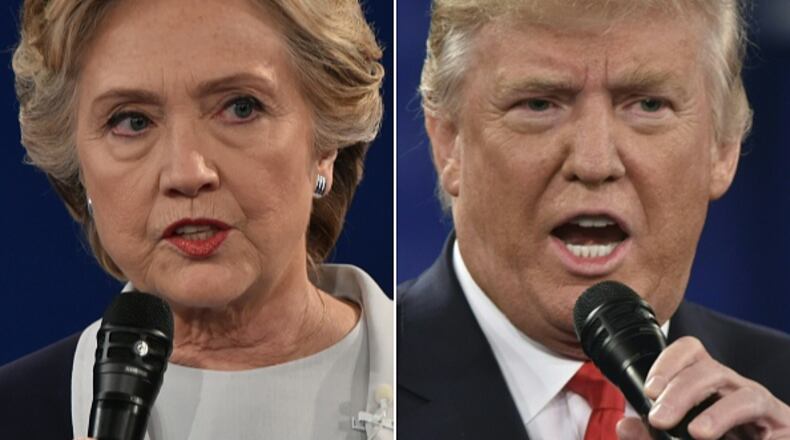1. Early voting. Ohio is one of 37 states, along with Washington, D.C., that allow early voting, and it has grown each election cycle so that one-third of the ballots were cast early in the 2012 election. The Pew Research Center said early voting across the country could top 50 million in 2016, well above the 46 million who cast early ballots four years ago. In Ohio, Secretary of State Jon Husted announced Monday that about 1.8 million voters have already cast their ballots, including 661,549 who did so in person. Just what will this mean tonight? Possibly fewer long lines and maybe an early edge for Clinton. In past years, early voters have trended more toward the Democratic Party, putting Republicans in a hole even before the polls open on Election Day. Several boards of election in Republican counties did report long lines throughout the final weekend as early voting came to close on Monday.
2. Turnout, particularly among African-Americans, Latinos and women. If Clinton gets high turnout among those groups, she will probably win. Trump, on the other hand, needs a boost in turnout from white men and blue-collar Americans who lack a college degree. He also needs traditional Republicans to support him, even though many big names in the party have said they will not vote for him. There are some early indications that favor Clinton. CNN reported that Latino voting in Florida, Georgia and North Carolina is up significantly over 2012 numbers. Latinos tend to vote more Democratic than the overall population.
3. Swing state voting. Ohio is still important, but it was notable that neither candidate made a stop here Monday, the final day of campaigning before Election Day. In 2012, both Barack Obama and Mitt Romney made Monday visits to Ohio. Keep an eye on Florida, North Carolina, Pennsylvania, Michigan, New Hampshire and yes, Ohio. If Clinton wins the White House without carrying Ohio, she'll be the first Democrat to do so in 56 years. The state is even more important to Trump, however. No Republican has ever won the presidency without winning Ohio. If Trump loses one or more of the big Eastern swing states — Florida, Pennsylvania, North Carolina — his chances for winning the needed 270 electoral votes become less likely.
4. Ohio women. According to the Democrats, women early voters in Ohio went for Clinton over Trump by a 23-percentage-point margin, which is even more significant when you consider that women represent 57 percent of Ohio's early vote electorate. But some polls had Trump polling well with women, despite a number of controversial statements and his "hot mic" moment in which he was caught on tape joking about sexual assault. A Quinnipiac Poll on Nov. 2 had Trump and Clinton running even among women in Ohio, with 44 percent apiece. To win the state — and the presidency — Clinton needs to hold a decisive advantage with women.
5. New voters. Both sides are banking on turnout from people who have either never voted or don't normally vote. This faction is very important to Trump, who has drawn bigger and far more enthusiastic crowds than Clinton. Trump has called his candidacy a movement, and says he is bringing legions of newcomers into the party. But will they vote in sufficiently large numbers to make the difference in the 14 or 15 states that most pollsters say are too close to call? For her part, Clinton has chased hard after the millennial vote, appearing on the concert stage in Cleveland Friday with Jay Z and wife Beyonce.
6. Trouble at the polls. Nobody wants this, and it's not clear what impact any disturbances might have on the actual vote, but election officials have bolstered security plans and training in case partisans attempt to intimidate voters or cause other trouble at the polls. Husted has appeared on national television assuring Ohioans their votes are safe, using his favorite line that it's easy to vote in Ohio but hard to cheat. Trump has said numerous times that the election is rigged and has not said that he will accept the results if he loses. Both sides will have poll-watchers inside the polling places and untold numbers outside. Ohio has strict rules against intimidating voters and elections officials have urged voters who feel threatened to inform an elections official inside the polling place or call 9-1-1.
7. Outsiders. A third party or independent hasn't won Electoral College votes since 1968 but Green Party candidate Jill Stein and Libertarian Party candidate Gary Johnson and independent Evan McMullin could pull votes from Trump and Clinton and have an out-sized impact on swing states. In 2000, Green party candidate Ralph Nader pulled more than 97,000 votes in Florida, where a less than 1,000 vote difference separated George W. Bush and Al Gore. McMullin, a former CIA agent, is running strongest in Utah, where Mormon Republicans are looking for an alternative to Trump. In early October, McMullin had been neck and neck with Trump in Utah, which has six electoral votes, but Trump has since taken a solid lead. Johnson is expected to take 4.7 percent of the national vote while Stein is expected to grab 1.9 percent, according to Real Clear Politics.
Speak out on the election
Tell us what you think on our Ohio Politics Facebook page
About the Author

